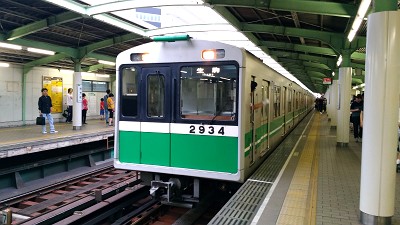
Click here for the latest page.
@
@
It is a train line figure (a subway, JR, and private Railways) in Osaka.
Although the route map of only a subway, or JR and Private Railways was obtained easily,
Subway, JR, and Private Railways were contained, and since the route map reproduced to the spatial relationship of a change was not found, it was made.
"New JR-Osaka Station (North Umeda Area) " will be open in March 2023 is included in this figure.
"JR Osaka Higashi-Line" opened in March 2019 is included in this figure.
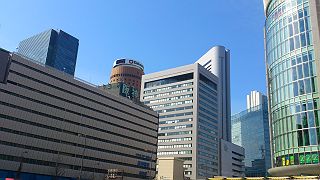 @
@
JR Osaka Station
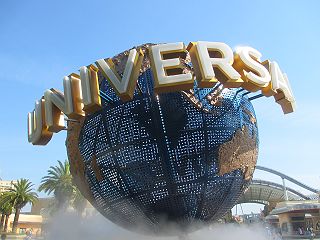
Universal Studio Japan(USJ) is located near "JR Universal City Station".
This is a railway route map around Osaka (JR, Subway, and Private Railway) .
![]() Download
OSAKA/JAPAN TRAIN MAP [PDF]
Download
OSAKA/JAPAN TRAIN MAP [PDF]
On this route map, the stations where you can transfer are displayed close to each other to make it easy to understand.
=> [ More big Image ]
@
Osaka Metro Subway' Map
The subway of Osaka is in a grid pattern [ foundations, and length and width ].It is because the road was formed in a grid pattern [ north and south ] like Kyoto and the subway was made into the underground.the vestiges of the jo-ri land system of Asuka and the Nara period -- it is also called ...
Coloring of the route of a subway, It has become.
‘ Red: Mido-Suji Line ‘ Blue: Yotsubashi Line
‘ Brown: Sakai-suji Line ‘ Purple: Tanimachi line
‘ Green: Chuo Line
‘ Peach color : Sennichimae Line
‘ Yellowish green: Nagahori-Tsurumi-ryokuchi-Line(linear mini subway)
‘ Orange : ImazatoSuji Line(linear mini subway)
‘ Light blue : Nanko Port-town Line (Newtram)
=> destination is a JR station, it is easier to change to JR and cheap.
It is easier to change and use a subway, when the destination is a station of a subway and
Private Railways.
When Shin-Osaka Station to JR stations (station of JR loop lines, such as nine articles of Osaka, Kyobashi and Tsuruhashi, Fukushima and Nishi, Benten-cho, and Taisho, etc.) are destinations, it rides on JR from Shin-Osaka Station, and it is [ way ] cheap and convenient.
When going to the stations (Hommachi, Namba, etc.) of a subway and Private Railways
from Shin-Osaka Station, it is a subway from Shin-Osaka Station.
Mido-suji Line, It is more convenient to ride.
however, the case where it goes also at a JR station to "Tennoji Station" (ABENO-BASHI) -- subway from Shin-Osaka Station It is more convenient to ride on the
Mido-suji Line.
However, only few of a fare is high.
"TO UNIVERSAL STUDIOS JAPAN"
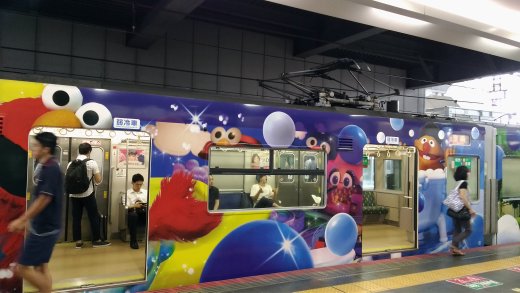 @
@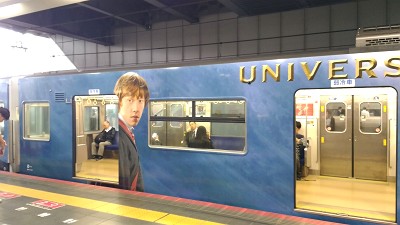
We use JR to Universal Studios Japan. From Osaka Station, take the platform number 1 (counterclockwise) of the JR Osaka Loop Line and transfer to "Sakurajima Station" at "Nishi Kujo Station" and get off at "Universal City Station".
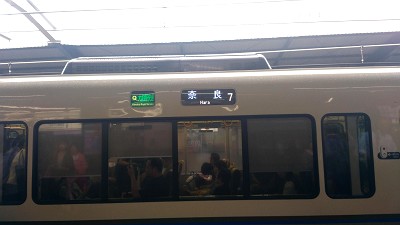
This is platform number 1 of Osaka Station. (To [NARA])
[UniversalCity and Sakurajima] => Direct Access to UNIVERSAL STUDIO JAPAN.
[OSAKA LOOP LINE], [NARA][KAMO][TAKADA][GOJO], [KANSAI AIRPORT][WAKAYAMA][HINENO]
=> Use their Train and Change at "Nishi-Kujo Station".
This picture is "Nishi-Kujo Station". At "Nishi-Kujo Station", transfer to the train bound for Sakurajima.
=> It can change (seemingly, it will be called "connection"). But ...
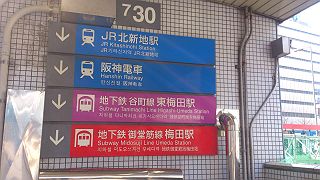
Although Umeda Station, West Umeda Station, and East Umeda Station of a subway are different stations, connection will be possible if it is less than 30 minutes.
West Umeda <- -> UmedaAUmeda <- -> East Umeda It requires for a change about 8-10 minutes in general.
West Umeda <- -> East Umeda It is that (400-500m) with slight distance, and requires about 10-15 minutes.
Since stations are connected in the underground center, connection is possible, without coming on the ground.
It is convenient when carrying out little shopping in 30 minutes in the underground center in Umeda.
It corrects... The underground of each neighboring building has joined together and the underground center in Umeda has underground and the place which is multilayers.
It is a little labyrinth.
Moreover, it has spread not in a clear passage like north, south, east and west but in field structure.
Let's progress, while looking at the guidance currently attached to the Amai part, if it wavers.
Since it must pass along a yellow-green automatic ticket gate when changing with a ticket, it is attention!
Chuo Line <- in the case of -> Yotsubashi Line, the change by the direction of Namba in Yotsubashi Line is comparatively convenient. If you walk along an accessway from the escalator at the westernmost end in Chuo Line, it will arrive at the home of the direction of Namba in Yotsubashi Line.
Chuo Line <- in the case of -> Mido-suji Line, it is the fastest the escalator at the easternmost end (Sakaisuji Hommachi side) in Chuo Line and to use southern (Tennoji side) escalator most of the Mido-suji Line, but it still requires about 5 minutes.
Mido-suji Line<- a change of -> Yotsubashi Line also has much stairs and up and down, and since at least the amount of 1 station walks, we cannot recommend it to you.
=> Midosuji line <- -> Yotsubashi Line It is Daikokucho Station if it is a change.
The change has become possible at the home on the other side.
In addition, the subway of Osaka has many stations which cross + character type and L character type, and has them, and the change of these stations is possible only by moving to the story of a story and [ upper ] the bottom.
Compared with Tokyo, I think that there are many stations convenient to change.
=>They are careful of NODA, IMAZATO, HIRANO, TENMA and TENMA-BASHI, ABENO and ABENO-BASHI, HONMACHI and UE-HONMACHI.
NODA:Please note that Noda Station on the JR Loop Line is far from Noda Station on the subway and Hanshin. By the way, Noda Station on the JR Loop Line is a transfer station at Tamagawa Station on the Sennichimae Subway Line.
IMAZATO: Since it is separated from Imazato Station of a subway and Kintetsu, it changes and it is not made.
HIRANO: Since JR and a subway are separated, it cannot change and do.
ABENO & ABENO-BASHI: The Kintetsu ABE-No-BASHI differs from ABENO of a subway, although the name is alike. The Kintetsu ABE-No-BASHI is the other side at Tennoji Station.
HONMACHI & UE-HONMACHI: Kintetsu "Osaka Ue-Hommachi" Station and "Subway Hommachi" Station are different stations.
TENMA & TENMA-BASHI: "Temma" Station on the JR Loop Line and "Temma-bashi" Station on the Keihan Subway are located in different places.
The following stations are a little far away and require attention.
UMEDA:Since it is separated from Umeda Station of Hanshin, Hankyu and a subway (West Umeda, Umeda, and East Umeda), and Osaka Station and each of JR, change time is required for it. He walks from Osaka Station and it requires north Shinchi Station about 15 minutes.
KYOBASHI: Since it is separated also from Kyobashi Station of Kyobashi Station of a long ditch Tsurumi-Green-Zone line, and Kyobashi Station in JR and Keihan for a while, it is necessary to see change time about 10 minutes.
TENNOJI: It is separated from Tennoji Station of the Midosuji line and the Tanimachi line for a while.
NAMBA: Since it is separated from Nankai Namba Station, JR Namba Station, and subway Namba Station for a while, respectively, it is necessary to see change time for 10 to 15 minutes.
=> Distant [ a little ] from Dotonbori or the Shinsaibashi line shopping center. There are 4 trains in daytime in 1 hour.
=> In Sakura-gawa, Namba to Tsuruhashi, Kintetsu is running near the Sennichimae line.
=> No. Only two are run in 1 hour.
=> Rush-hour comes one after another.
In case of the Mido-suji line, rush-hour will come, if it waits from 3 for 4 minutes a 1.5-minute interval and daytime also.
It is more than Yamanote Line(Tokyo).
Other subway lines are run from rush-hour 3 minutes, and it is running at intervals of 10 minutes from 7 minutes at intervals of 5 minutes daytime.
In a subway, operation frequency has least ImazatoSuji Line.
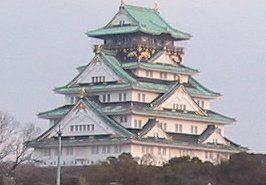 @
@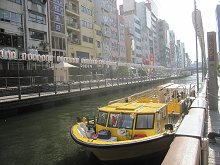
Stay hotels popular in Osaka have gathered in the following area greatly.
In addition, comparatively new hotels have gathered around Universal Studios, and since access to the central part is not bad, either, use as a no-frills hotel is also recommended unexpectedly.
=> ‘(2)Yodoyabashi, Hommachi, Kitahama, and the Higo-Bashi area
=> ‘(3)Shinsaibashi and Namba area
=> ‘(4)Universal Studio area / Benten-cho area
=> ‘(5) The Shin-Osaka Station area
=> ‘(6)Osaka Castle area
=> ‘(7)Tennoji, Abeno, and Uehommachi area